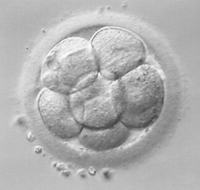Transfer of frozen or vitrified embryos
 This technique involves thawing or devitrification of surplus embryos from a previous In Vitro Fertilisation cycle for another chance to achieve pregnancy. For this, the patient will have to take hormone treatment to prepare her endometrium.
This technique involves thawing or devitrification of surplus embryos from a previous In Vitro Fertilisation cycle for another chance to achieve pregnancy. For this, the patient will have to take hormone treatment to prepare her endometrium.
How is the embryo transferred?
The transfer is carried out in the operating theatre under the guidance of an abdominal ultrasound in order to deposit the embryos into the centre of the uterine cavity, to obtain the best pregnancy rate.
Which embryos are selected? What are the criteria for selection?
Embryos generated by an IVF cycle are maintained in culture for two or three days until the time of transfer. Embryos that best meet the quality criteria are selected for transfer.
Current Spanish law allows the transfer of a maximum of 3 embryos. However, to reduce the chances of multiple pregnancies, the most usual is to transfer two embryos. The decision on the number of embryos to transfer should be personalised for each couple and the factors to consider are the age of the woman, the quality of embryos and previous reproductive history, if any.
Is it a painful procedure?
The procedure is the same as a gynaecological check-up, and may be slightly uncomfortable but it is not usually painful. However, in some cases, if passing through the cervix is expected to be difficult, the transfer may be performed under anaesthetic.
After the treatment, what does the patient need to be careful about?
In addition to taking the medication prescribed by your doctor, two days rest is usually recommended, while avoiding physical exertion until you find out the results of your pregnancy test.
What happens to the embryos that are not transferred?
The future of the embryos that are not transferred depends on their quality. Embryos that meet certain quality minimums are vitrified, while poor quality surplus embryos are discarded.



















